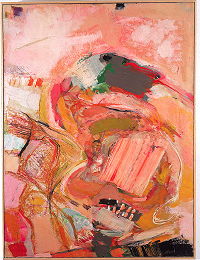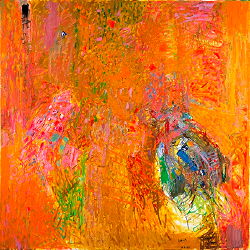Paris finally dedicates a retrospective exhibition to Shafic Abboud, one of the foremost Lebanese painters of the second half of the 20th century. Shafic Abboud’s paintings are a manifesto for freedom, colour, light and joy, as well as being a permanent bridge between the art scenes of France and Lebanon and that of Lebanon and the Middle East. The exhibition sheds light on Shafic Abboud’s paintings, comprising of 190 works of various sizes, dating from all his periods (1948-2003) and coming from many different provenances. Hopefully further exhibitions will present other aspects of the artist’s multifaceted creativity, such as his artist’s books, his prints and lithographs, his ceramics and terracottas, his carpets and tapestries, his sculpture designs…
 Shafic Abboud, A l'atelier, 1970. Oil on canvas, 130 x 97 cm. Private collection, Paris. © ADAGP. Courtesy Succession Shafic Abboud, Paris.
Shafic Abboud was from a Lebanese Arab modern culture. The stories of his grandmother, who was the village’s story-teller, left an indelible mark on him, at a very early age. He was immersed in the very colourful popular culture of the villages of Mount Lebanon and was familiar with the paintings of the travelling story-tellers. The artist’s eye was also strongly influenced by Byzantine icons and traditions from his church. The writings, debates, ideals, hopes and battles characterising the Arab Nahda, a modernist and anti-clerical Renaissance which was initially driven by 19th century Lebanese writers and thinkers, were to later have a significant impact on Abboud’s intellectual education.
The influence of Bonnard and de Staël
Born in 1926 in Lebanon, Shafic Abboud arrived in 1947 in Paris, only provided with letters of introduction by poet Georges Schéhadé, and blended in perfectly with the city’s artistic life, just as many other artists who had come from all over the world after the Second World War. Shafic Abboud had a particular preference for works by Pierre Bonnard, Roger Bissière and Nicolas de Staël. His first personal exhibition as a figurative painter took place in Beirut in 1950, whilst his first solo exhibition as an abstract painter was held in Paris in 1955. Art critics acknowledged the quality of Abboud’s painting at a very early stage in his life. He was the only artist from the Arab world to participate to the first Biennale of Paris in 1959. In Lebanon, from the 1950s to the 1970s, he played a major role for Beirut’s cultural and artistic life, where he taught at the Lebanese University. He participated to the FIAC in Paris, from 1983 onwards. When Abboud passed away in April 2004, a moving farewell ceremony was organised at the Parc Montsouris in Paris’ 14th district, very close to where the artist had his small studio. Abboud then received a triumphant welcome, when his body was transferred to Beirut and to Mount Lebanon, where he was buried, as per his wish.
 Shafic Abboud, Les filles, 2000. Oil on canvas, 125 x 125 cm. © ADAGP. Courtesy Succession Shafic Abboud, Paris.
Abboud’s painting gradually moved from the poetic Lebanese figuration towards the lyrical Parisian abstraction, followed by a move from abstraction towards a very subtle and personal “transfiguration”, which was simultaneously traditional and modern, pagan and sacred. On a permanent quest, Abboud experiments, gets excited by his discoveries, doubts and reassesses. However, he is also faithful to different aspects of a series of continuous themes such as seasons, windows, studios, rooms, nights, destroyed cafés (large colourful compositions recalling the tragic reality of the war in Lebanon, devastating the cafés by the sea in Beirut, where he loved to go with his friends), the temperas of the childhood world, the temperas of ancient Arab poets, Simone’s dresses (a friend of his whose dresses fascinated him with their various shimmering fabrics). His work is often an invitation to the joy of life, a pagan hedonism yet limited by our frail human condition.
PUBLICATION:
1 -The first retrospective of a great Lebanese and Parisian artist
Shafic Abboud, J'ai reve que, 1977, 162 x 130 cm. © ADAGP. Courtesy Succession Shafic Abboud, Paris.
INSTITUT DU MONDE ARABE
1, rue des Fossés-Saint-Bernard
75005 Paris
INFORMATION:
Tel 01 40 51 38 38
http://www.imarabe.org
http://www.abboud-retrospectives.org
OPENING HOURS:
From Tuesday to Sunday, 11AM to 6PM. Closed on Monday.
ENTRANCE FEES:
Full rate €7
Reduced rate €5
CURATORSHIP:
Claude Lemand
PRESS CONTACT:
Claude Lemand
E-mail : clemand@wanadoo.fr
Paris finally dedicates a retrospective exhibition to Shafic Abboud, one of the foremost Lebanese painters of the second half of the 20th century. Shafic Abboud’s paintings are a manifesto for freedom, colour, light and joy, as well as being a permanent bridge between the art scenes of France and Lebanon and that of Lebanon and the Middle East. The exhibition sheds light on Shafic Abboud’s paintings, comprising of 190 works of various sizes, dating from all his periods (1948-2003) and coming from many different provenances. Hopefully further exhibitions will present other aspects of the artist’s multifaceted creativity, such as his artist’s books, his prints and lithographs, his ceramics and terracottas, his carpets and tapestries, his sculpture designs…
Shafic Abboud, A l'atelier, 1970. Oil on canvas, 130 x 97 cm. Private collection, Paris. © ADAGP. Courtesy Succession Shafic Abboud, Paris.A colourful popular culture
Shafic Abboud was from a Lebanese Arab modern culture. The stories of his grandmother, who was the village’s story-teller, left an indelible mark on him, at a very early age. He was immersed in the very colourful popular culture of the villages of Mount Lebanon and was familiar with the paintings of the travelling story-tellers. The artist’s eye was also strongly influenced by Byzantine icons and traditions from his church. The writings, debates, ideals, hopes and battles characterising the Arab Nahda, a modernist and anti-clerical Renaissance which was initially driven by 19th century Lebanese writers and thinkers, were to later have a significant impact on Abboud’s intellectual education.
The influence of Bonnard and de Staël
Born in 1926 in Lebanon, Shafic Abboud arrived in 1947 in Paris, only provided with letters of introduction by poet Georges Schéhadé, and blended in perfectly with the city’s artistic life, just as many other artists who had come from all over the world after the Second World War. Shafic Abboud had a particular preference for works by Pierre Bonnard, Roger Bissière and Nicolas de Staël. His first personal exhibition as a figurative painter took place in Beirut in 1950, whilst his first solo exhibition as an abstract painter was held in Paris in 1955. Art critics acknowledged the quality of Abboud’s painting at a very early stage in his life. He was the only artist from the Arab world to participate to the first Biennale of Paris in 1959. In Lebanon, from the 1950s to the 1970s, he played a major role for Beirut’s cultural and artistic life, where he taught at the Lebanese University. He participated to the FIAC in Paris, from 1983 onwards. When Abboud passed away in April 2004, a moving farewell ceremony was organised at the Parc Montsouris in Paris’ 14th district, very close to where the artist had his small studio. Abboud then received a triumphant welcome, when his body was transferred to Beirut and to Mount Lebanon, where he was buried, as per his wish.
Shafic Abboud, Les filles, 2000. Oil on canvas, 125 x 125 cm. © ADAGP. Courtesy Succession Shafic Abboud, Paris.Seasons, windows and destroyed cafés
Abboud’s painting gradually moved from the poetic Lebanese figuration towards the lyrical Parisian abstraction, followed by a move from abstraction towards a very subtle and personal “transfiguration”, which was simultaneously traditional and modern, pagan and sacred. On a permanent quest, Abboud experiments, gets excited by his discoveries, doubts and reassesses. However, he is also faithful to different aspects of a series of continuous themes such as seasons, windows, studios, rooms, nights, destroyed cafés (large colourful compositions recalling the tragic reality of the war in Lebanon, devastating the cafés by the sea in Beirut, where he loved to go with his friends), the temperas of the childhood world, the temperas of ancient Arab poets, Simone’s dresses (a friend of his whose dresses fascinated him with their various shimmering fabrics). His work is often an invitation to the joy of life, a pagan hedonism yet limited by our frail human condition.
PUBLICATION:
1 - SHAFIC ABBOUD Retrospective. Catalogue, Paris, 2011. Researched and published by Claude Lemand, in conjunction with the retrospective at the IMA. Bound, 70 pages in colour, 25 x 34 cm. Texts by Shafic Abboud, Christine Abboud, Lydia Harambourg, Sophie Krebs, Claude Lemand, Issa Makhlouf. ISBN 2-910263-07-2. Public Price 20 €
2- SHAFIC ABBOUD. Monograph, Paris, 2006. First book researched and published by Claude Lemand, 368 pages in colour, 250 x 335 mm. Bound in a case illustrated in colour. ISBN 2-910263-06-1. Public Price 150 €
To see more illustrations, click on VERSION FRANCAISE at the top
of this page
2- SHAFIC ABBOUD. Monograph, Paris, 2006. First book researched and published by Claude Lemand, 368 pages in colour, 250 x 335 mm. Bound in a case illustrated in colour. ISBN 2-910263-06-1. Public Price 150 €
To see more illustrations, click on VERSION FRANCAISE at the top
of this page
|




